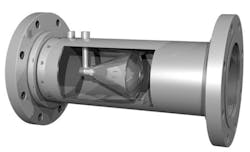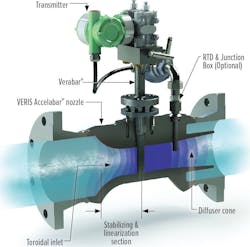Most all processes involve some kind of acceleration to the media you are trying to move. And the only way to achieve acceleration in a process is through some variant of a force.
In case it has been a while since you have studied your equations, remember that Force (F) = Mass (M) x Acceleration (A). Further, it is important to remember that M = Volume (V) x its Density (D). With this in mind, we know that we can accelerate fluid by applying a difference in pressure across its length, and that this pressure will be proportional to its density and its acceleration. Achieving this differential pressure is done through a device such as a differential pressure flowmeter. However, there have been different models over the course of time with varying advantages and disadvantages associated with them. In fact, differential pressure flowmeters have a unique history in industry.
According to the Measurement, Control & Automation Association (MCAA), “A common way to accelerate fluid in a pipeline is to pass it through a constriction device or a fitting such as an elbow. The constriction will increase the fluid’s velocity. When the differential pressure transmitters are placed across these devices in pipes, they measure the pressure drop resulting from the acceleration change. Orifice plates, Venturis, wedges and cones are flow measurement devices using this principle.”
These distinct types of differential pressure (D.P.) flowmeters are the subject of this analysis.
Orifice plates/flow nozzles
Right around the turn of the century, orifice plates quickly became the most common/primary approach for closed pipe flow measurement. One of this model’s most attractive features is its ease of installation. An orifice plate mounts between two orifice unions/flanges so the complexity of implementation is kept to a minimum. As the industry has evolved, these were still widely accepted, thus maintenance has remained relatively inexpensive.
That is not to say that orifice plates are not without some drawbacks as well. First, they can be prone to dirt and debris interfering with its accuracy. Further, the wear on the orifice itself can also lead to a loss of accuracy. This model also showcases a high permanent pressure loss (PPL) and minimal turndown ratio. Finally, the long pipe length required to utilize an orifice plate is necessary to develop a clean flow profile.
Flow nozzles are similar except have a contoured reduced I.D. exit nozzle, in place of the orifice plate. This design was used on process flows with entrained solids or high velocity flow which could damage the orifice plate’s sharp edge.
Venturis
Just like the orifice plates previously discussed, Venturi would also be classified as widely accepted technology, utilized as custody transfer meters. Unlike the orifice plates, however, Venturi maintains a relatively low PPL. Additionally, Venturis typically boast a higher accuracy than the orifice plates, roughly +/- 0.5%. On the other hand, Venturis have their fair share of negative attributes. Venturis need very long straight pipe meter runs and commonly straightening vanes to meet required accuracies, the meter bodies are quite lengthy, and are very costly to purchase and install.
Pitot tubes
Finally, from an “historic” perspective, the Pitot tubes developed by Henri Pitot in the 1700s. He used a glass Pitot tube to measure river flowrate. On the positive side, installing Pitot tubes is relatively inexpensive. It is also a widely accepted technology for air flow measurements. However, there are a few cons to Pitot tubes. Unfortunately, they only allow for a single point of measurement and can only produce a low differential pressure.
Averaging Pitot tubes
Over the last half-century there have been some advancements in the design of flowmeters. As outlined earlier, there were some shortcomings with the orifice plate and the Venturi meters. One such development was the Averaging Pitot tubes. These were designed to span the entire ID of the pipe to measure the average velocity. Averaging Pitot tubes facilitate a simple, inexpensive installation with a 2-inch weld-o-let welded to the exterior of the pipe and a compression fitting. For pipes of a larger size, this approach is very cost effective. The technology provides good, long-term accuracy and repeatability, typically a +/- of 1%. Finally, through Averaging Pitot tubes, there is a low PPL, which ultimately reduces pumping costs.
Unfortunately, however, the fixed restriction results in low differential pressure outputs and has a limited Reynolds number range with typically a 5:1 flow turndown ratio. Also, this technology is most often used on clean processes. It is not suitable for entrained solids or slurries.
V-cone/cone
The V-cone or cone technology features a cone obstruction mounted in a full pipe size body, creating the differential pressure from the upstream to the downstream of the cone. On the plus side, with this technology, a 10:1 turndown ratio is typical. Additionally, the V-cone allowed for selectable beta ratios to optimize the D.P. range and/or a low PPL. Each meter is flow tested to determine its “K-Factor,” and unlike a couple of the previously technologies mentioned, a minimal pipe run is required.
This technology does come with a costly installation process. It requires removing a section of pipe and installing mating flanges, similar to a Venturi.
Accelebar
The Accelebar is an averaging Pitot tube installed in the throttle of a flow nozzle. It is a full-line size body. Through this technology, a 30:1 turndown can be achieved, if your flow velocity is high enough. It produces high differential pressure and a low PPL. It also boasts both long-term accuracy and repeatability, typically a +/- of 0.5%. Lastly, there is no requirement for an upstream straight pipe run as the flow nozzle conditions the flow profile. This is another full-body meter where installation can be costly, just like Venturis and V-cone.
Wedge meter
With this approach, the wedge is installed perpendicular to the flow direction, creating restriction. The wedge meter was designed for dirty, high suspended-solid flows and slurries. It features selectable beta ratios to optimize the differential pressure range and/or low PPL. The repeatability and accuracy are maintained over a long period of time, typically +/- 1%. However, as with Venturi, V-cone and Accelebar, the Wedge meter requires the same costly installation, necessitating pipe removal and mating flange installation. Uniquely to the wedge meter, however, this technology is usually used with diaphragm seals on the sensing ports, adding additional cost to the transmitter installation.
There are many new flowmeter technologies at your disposal — ultrasonic, Coriolis, vortex and thermal mass to name a few.
The need to measure flow using differential pressure in various processes is not going away any time soon. However, as highlighted in this article, there are many different D.P. flowmeter designs to achieve long-term dependable, accurate flow measurement. What is most important is that the technology selected is the best suited for your specific process. It is important to consult a professional to discuss which flowmeter would be best for your application.
Steve Molinari is a Technical Sales Engineer at Valin Corporation, a subsidiary of Graybar, and the leading technical solutions provider for the technology, energy, life sciences, natural resources, and transportation industries. For 50 years, Valin has offered personalized order management, on-site field support, comprehensive training, and applied expert engineering services utilizing automation, fluid management, precision measurement, process heating, and filtration products.
Valin Corporation



